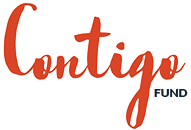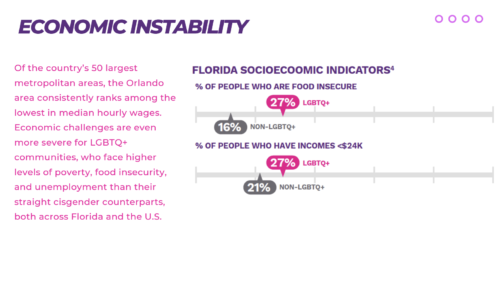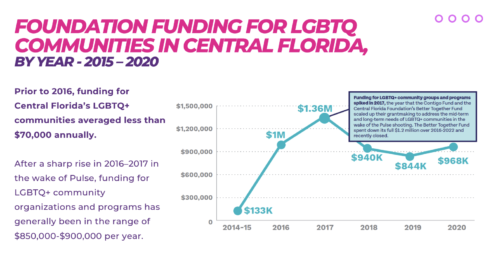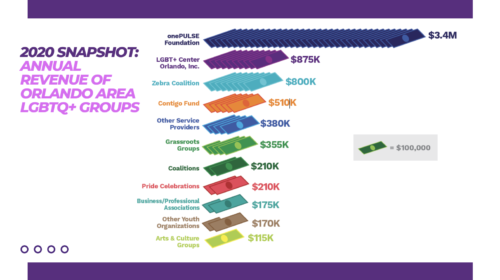The Contigo Fund and Funders for LGBTQ Issues have conducted an extensive study on the state of funding for the Orlando area’s LGBTQ+ nonprofits and community groups six years after the Pulse massacre left local communities reeling and drew attention from donors and funders around the globe. The purpose of the report is to establish a baseline and measure progress toward building a sustainable ecosystem to address the full needs of the region’s diverse LGBTQ+ communities. It includes data on community needs, funding levels and top funding sources from 2017-2020, and a snapshot of the resources of local LGBTQ+ nonprofits in 2020. Highlights from the report are below. Download and read the report by clicking the button above.
The Needs
The first section of the report focuses on the need for funding by highlighting key issues facing LGBTQ+ communities in the region.
LGBTQ+ Population
The Orlando Metropolitan area ranks 7th in the country for largest percentage of LGBTQ+ adults in the nation with over 100,000 LGBTQ+ adults.
HIV/AIDS
Despite its growing number of service providers focusing on HIV care, the Orlando metropolitan area continues to rank among the highest metropolitan areas in the nation in new HIV infections. Like most other places in the South, the brunt of the epidemic is felt by communities of color and the LGBTQ+ community.
Economic Instability
Orlando has some of the lowest median hourly wages in the country, and LGBTQ+ communities in Florida and across the country are more likely to have low incomes and face food insecurity.
Regressive Legislature
Florida has recently passed a wave of bills seeking to marginalize LGBTQ+ communities, immigrants, people of color, and women – but Central Florida’s grassroots communities are fighting back and building trailblazing models for progressive coalition-building and resistance in the South.
The Funding
The report finds that foundation and corporate funding for Orlando’s LGBTQ+ nonprofits and programs rose for two years after the Pulse shooting, reaching a peak of nearly $1.4 million in 2017. After that, however, funding quickly tapered off, dropping to a range of $850,000-$950,000 between 2018 and 2020, the most recent year for which complete funding data are available. This section also includes a list of the top ten funders of LGBTQ+ communities in the region.
The Snapshot of 2020
The report also includes original research on more than 30 LGBTQ+ community organizations in the Orlando area – a robust and varied set of organizations ranging from community centers and mental health service providers to grassroots advocacy groups and coalitions. Twenty of these local LGBTQ+ community organizations were founded since Pulse, half of which are led by and for LGBTQ+ communities of color–pointing to how the region’s LGBTQ+ nonprofit sector has grown in both scale and diversity in the past six years.
For Funders
The final section of the report outlines opportunities for funders to support Orlando’s growing, diverse, and impactful ecosystem of LGBTQ+ nonprofits and community groups.






